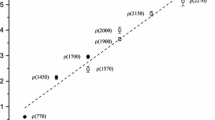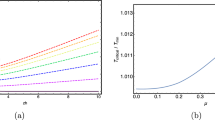Abstract
We study various methods for estimating the deconfinement temperature in nondynamical bottom-up AdS/QCD models in detail. We show that although there are many different possibilities to define the holographic parameters, certain reasonable theoretical and phenomenological restrictions on holographic models lead to realistic and rather stable predictions for the range of temperatures in the deconfinement crossover region at small baryon densities. In particular, we argue that the most successful approach is to take the scalar glueball trajectory from lattice simulations as a basic input in an improved version of the soft-wall holographic model.
Similar content being viewed by others
References
E. Witten, “Anti-de Sitter space, thermal phase transition, and confinement in gauge theories,” Adv. Theor. Math. Phys., 2, 505–532 (1998); arXiv:hep-th/9803131v2 (1998).
C. P. Herzog, “Holographic prediction for the deconfinement temperature,” Phys. Rev. Lett., 98, 091601 (2007); arXiv:hep-th/0608151v3 (2006).
J. Erlich, E. Katz, D. T. Son, and M. A. Stephanov, “QCD and a holographic model of hadron,” Phys. Rev. Lett., 95, 261602 (2005); arXiv:hep-ph/0501128v2 (2005).
L. Da Rold and A. Pomarol, “Chiral symmetry breaking from five-dimensional spaces,” Nucl. Phys. B, 721, 79–97 (2005); arXiv:hep-ph/0501218v3 (2005).
A. Karch, E. Katz, D. T. Son, and M. A. Stephanov, “Linear confinement and AdS/QCD,” Phys. Rev. D, 74, 015005 (2006); arXiv:hep-ph/0602229v2 (2006).
S. S. Afonin and A. D. Katanaeva, “Holographic estimates of the deconfinement temperature,” Eur. Phys. J. C, 74, 3124 (2014); arXiv:1408.6935v2 [hep-ph] (2014).
S. S. Afonin and A. D. Katanaeva, “Glueballs and deconfinement temperature in AdS/QCD,” Phys. Rev. D, 98, 114027 (2018); arXiv:1809.07730v2 [hep-ph] (2018).
L. Da Rold and A. Pomarol, “The scalar and pseudoscalar sector in a five-dimensional approach to chiral symmetry breaking,” JHEP, 0601, 157 (2006); arXiv:hep-ph/0510268v1 (2005).
P. Colangelo, F. D. Fazio, F. Giannuzzi, F. Jugeau, and S. Nicotri, “Light scalar mesons in the soft-wall model of AdS/QCD,” Phys. Rev. D, 78, 055009 (2008); arXiv:0807.1054v1 [hep-ph] (2008).
H. Boschi-Filho and N. R. F. Braga, “QCD/String holographic mapping and glueball mass spectrum,” Eur. Phys.J. C, 32, 529–533 (2004); arXiv:hep-th/0209080v3 (2002).
P. Colangelo, F. D. Fazio, F. Jugeau, and S. Nicotri, “On the light glueball spectrum in a holographic description of QCD,” Phys. Lett. B, 652, 73–78 (2007); arXiv:hep-ph/0703316v1 (2007).
H. Forkel, “Holographic glueball structure,” Phys. Rev. D, 78, 025001 (2008); arXiv:0711.1179v2 [hep-ph] (2007).
P. Colangelo, F. De Fazio, F. Jugeau, and S. Nicotri, “Investigating AdS/QCD duality through scalar glueball correlators,” Internat. J. Modern Phys. A, 24, 4177–4192 (2009); arXiv:0711.4747v2 [hep-ph] (2007).
D. Li and M. Huang, “Dynamical holographic QCD model for glueball and light meson spectra,” JHEP, 1311, 088 (2013); arXiv:1303.6929v2 [hep-ph] (2013).
S. P. Bartz, A. Dhumuntarao, and J. I. Kapusta, “Dynamical AdS/Yang-Mills model,” Phys. Rev. D, 98, 026019 (2018); arXiv:1801.06118v2 [hep-th] (2018).
D. Bugg, “Four sorts of meson,” Phys. Rep., 397, 257–358 (2004); arXiv:hep-ex/0412045v1 (2004).
S. S. Afonin, “Properties of possible new unflavored mesons below 2.4 GeV,” Phys.Rev.C, 76, 015202 (2007); arXiv:0707.0824v1 [hep-ph] (2007).
S. S. Afonin, “Light meson spectrum and classical symmetries of QCD,” Eur. Phys. J. A, 29, 327–335 (2006); arXiv:hep-ph/0606310v2 (2006).
G. Boyd, J. Engels, F. Karsch, E. Laermann, C. Legeland, M. Lutgemeier, and B. Petersson, “Thermodynamics of SU(3) lattice gauge theory,” Nucl. Phys. B, 469, 419–444 (1996); arXiv:hep-lat/9602007v1 (1996).
Y. Iwasaki, K. Kanaya, T. Kaneko, and T. Yoshie, “Scaling of the critical temperature and the quark potential with a renormalization group improved SU(3) gauge action,” Nucl. Phys. B Proc. Suppl., 53, 429–431 (1997); arXiv:hep-lat/9608090v1 (1996).
B. Lucini, A. Rago, and E. Rinaldi, “SU(N c) gauge theories at deconfinement,” Phys. Lett. B, 712, 279–283 (2012); arXiv:1202.6684v2 [hep-lat] (2012).
A. Andronic et al., “Hadron production in ultra-relativistic nuclear collisions: Quarkyonic matter and a triple point in the phase diagram of QCD,” Nucl. Phys. A, 837, 65–86 (2010); arXiv:0911.4806v3 [hep-ph] (2009).
S. Borsányi, Z. Fodor, C. Hoelbling, S. D. Katz, S. Krieg, C. Ratti, and K. K. Szabó, “Is there still any T c mystery in lattice QCD? Results with physical masses in the continuum limit III,” JHEP, 1009, 073 (2010); arXiv:1005.3508v1 [hep-lat] (2010).
P. Steinbrecher and HotQCD Collab., “The QCD crossover at zero and non-zero baryon densities from lattice QCD,” Nucl. Phys. A, 982, 847–850 (2019); arXiv:1807.05607v1 [hep-lat] (2018).
A. Vega and P. Cabrera, “Family of dilatons and metrics for AdS/QCD models,” Phys. Rev. D, 93, 114026 (2016); arXiv:1601.05999v2 [hep-ph] (2016).
C. A. Ballon Bayona, H. Boschi-Filh, N. R. F. Braga, and L. A. Pando Zaya, “On a holographic model for confinement/deconfinement,” Phys. Rev. D, 77, 046002 (2008); arXiv:0705.1529v3 [hep-th] (2007).
U. Gursoy, E. Kiritsis, and F. Nitti, “Exploring improved holographic theories for QCD: part II,” JHEP, 0802, 019 (2008); arXiv:0707.1349v3 [hep-th] (2007).
O. Andreev and V. I. Zakharov, “Heavy-quark potentials and AdS/QCD,” Phys. Rev. D, 74, 025023 (2006); arXiv:hep-ph/0604204v3 (2006).
O. Andreev and V. I. Zakharov, “The spatial string tension, thermal phase transition, and AdS/QCD,” Phys. Lett. B, 645, 437–441 (2007); arXiv:hep-ph/0607026v1 (2006).
Y. Yang and P.-H. Yuan, “Confinement-deconfinement phase transition for heavy quarks in a soft wall holographic QCD model,” JHEP, 1512, 161 (2015); arXiv:1506.05930v2 [hep-th] (2015).
M.-W. Li, Y. Yang, and P.-H. Yuan, “Approaching confinement structure for light quarks in a holographic soft wall QCD model,” Phys. Rev. D, 96, 066013 (2017); arXiv:1703.09184v1 [hep-th] (2017).
I. Aref’eva and K Rannu, “Holographic anisotropic background with confinement-deconfinement phase transition,” JHEP, 1805, 206 (2018); arXiv:1802.05652v3 [hep-th] (2018).
S. He, S.-Y. Wu, Y. Yang, and P.-H. Yuan, “Phase structure in a dynamical soft-wall holographic QCD mode,” JHEP, 1304, 093 (2013); arXiv:1301.0385v1 [hep-th] (2013).
D. Dudal and S. Mahapatra, “Thermal entropy of a quark-antiquark pair above and below deconfinement from a dynamical holographic QCD model,” Phys. Rev. D, 96, 126010 (2017); arXiv:1708.06995v3 [hep-th] (2017).
J. Maldacena, “The large N limit of superconformal field theories and supergravity,” Internat. J. Theor. Phys., 38, 1113–1133 (1999); arXiv:hep-th/9711200v3 (1997).
S. S. Gubser, I. R. Klebanov, and A. M. Polyakov, “Gauge theory correlators from non-critical string theory,” Phys. Lett. B, 428, 105–114 (1998); arXiv:hep-th/9802109v2 (1998).
E. Witten, “Anti de Sitter space and holography,” Adv. Theor. Math. Phys., 2, 253–291 (1998); arXiv:hep-th/9802150v2 (1998).
S. J. Brodsky, G. F. de Téramond, H. G. Dosch, and J. Erlich, “Light-front holographic QCD and emerging confinement,” Phys. Rep., 584, 1–105 (2015); arXiv:1407.8131v2 [hep-ph] (2014).
H. B. Meyer, “Glueball Regge trajectories,” Doctoral dissertation, Oxford Univ., Oxford (2004); arXiv:hep-lat/0508002v1 (2005).
S. S. Afonin, “Generalized soft wall model,” Phys. Lett. B, 719, 399–403 (2013); arXiv:1210.5210v2 [hep-ph] (2012).
S. S. Afonin, “Soft-wall modelling of meson spectra,” Acta Phys. Polon. Supp., 9, 597–602 (2016); arXiv: 1604.02903v2 [hep-ph] (2016).
M. Tanabashi et al. [Particle Data Group], “Review of particle physics,” Phys. Rev. D, 98, 030001 (2018).
A. V. Anisovich, V. V. Anisovich, and A. V. Sarantsev, “Systematics of \(q\overline q \) states in the (n, M 2)and (J, M 2) planes,” Phys. Rev. D, 6, 051502 (2000); arXiv:hep-ph/0003113v1 (2000).
E. Klemp and A. Zaitsev, “Glueballs, hybrids, multiquarks: Experimental facts versus QCD inspired concepts,” Phys. Rep., 454, 1–202 (2007); arXiv:0708.4016v1 [hep-ph] (2007)
M. Shifman and A. Vainshtein, “Highly excited mesons, linear Regge trajectories, and the pattern of the chiral symmetry realization,” Phys. Rev. D, 77, 034002 (2008); arXiv:0710.0863v3 [hep-ph] (2007)
S. S. Afonin, “Experimental indication on chiral symmetry restoration in meson spectrum,” Phys. Lett. B, 639, 258–262 (2006); arXiv:hep-ph/0603166v2 (2006)
“Towards understanding broad degeneracy in non-strange mesons,” Modern Phys. Lett. A, 22, 1359–1371 (2007); arXiv:hep-ph/0701089v2 (2007)
“Parity doubling in particle physics,” Internat. J. Modern Phys. A, 22, 4537–4586 (2007); arXiv:0704.1639v3 [hep-ph] (2007)
“Hydrogen like classification for light nonstrange mesons,” Internat. J. Modern Phys. A, 23, 4205–4217 (2008); arXiv:0709.4444v2 [hep-ph] (2007)
“Implications of the Crystal Barrel data for meson-baryon symmetries,” Modern Phys. Lett. A, 23, 3159–3166 (2008); arXiv:0707.1291v2 [hep-ph] (2007)
D. M. Li, B. Ma, Y. X. Li, Q. K. Yao, and H. Yu, “Meson spectrum in Regge phenomenology,” Eur. Phys. J. C, 37, 323–333 (2004); arXiv:hep-ph/0408214v1 (2004)
S. S. Afonin and I. V. Pusenkov, “Universal description of radially excited heavy and light vector mesons,” Phys. Rev. D, 90, 094020 (2014); arXiv:1411.2390v1 [hep-ph] (2014)
“Note on universal description of heavy and light mesons,” Modern Phys. Lett. A, 29, 1450193 (2014); arXiv:1308.6540v2 [hep-ph] (2013).
P. Masjuan, E. Ruiz Arriola, and W. Broniowski, “Systematics of radial and angular-momentum Regge trajectories of light nonstrange \(q\overline q \)-states,” Phys. Rev. D, 85, 094006 (2012).
C. J. Morningstar and M. J. Peardon, “The glueball spectrum from an anisotropic lattice study,” Phys. Rev. D, 60, 034509 (1999); arXiv:hep-lat/9901004v2 (1999).
Y. Chen, A. Alexandru, S. J. Dong et al., “Glueball spectrum and matrix elements on anisotropic lattices,” Phys. Rev. D, 73, 014516 (2006); arXiv:hep-lat/0510074v1 (2005).
E. Gregory, A. Irving, B. Lucini, C. McNeile, A. Rago, C. Richards, and E. Rinaldi, “Towards the glueball spectrum from unquenched lattice QCD,” JHEP, 1210, 170 (2012); arXiv:1208.1858v2 [hep-lat] (2012).
B. Lucini, M. Teper, and U. Wenger, “Glueballs and k-strings in SU(N) gauge theories: Calculations with improved operators,” JHEP, 0406, 012 (2004); arXiv:hep-lat/0404008v1 (2004).
F. E. Close and Q. Zhao, “Production of f 0(1710), f 0(1500), and f 0(1370) in J/ψ hadronic decays,” Phys. Rev. D, 71, 094022 (2005); arXiv:hep-ph/0504043v2 (2005).
H. Y. Cheng, C.-K. Chua, and K.-F. Liu, “Revisiting scalar glueballs,” Phys. Rev. D, 92, 094006 (2015); arXiv:1503.06827v3 [hep-ph] (2015).
Author information
Authors and Affiliations
Corresponding author
Additional information
Conflict of interest
The authors declare no conflicts of interest.
Prepared from an English manuscript submitted by the authors; for the Russian version, see Teoreticheskaya i Matematicheskaya Fizika, Vol. 200, No. 3, pp. 532–552, September, 2019.
Rights and permissions
About this article
Cite this article
Katanaeva, A.D., Afonin, S.S. Estimates of the Deconfinement Temperature in ADS/QCD. Theor Math Phys 200, 1383–1400 (2019). https://doi.org/10.1134/S0040577919090113
Received:
Revised:
Accepted:
Published:
Issue Date:
DOI: https://doi.org/10.1134/S0040577919090113




